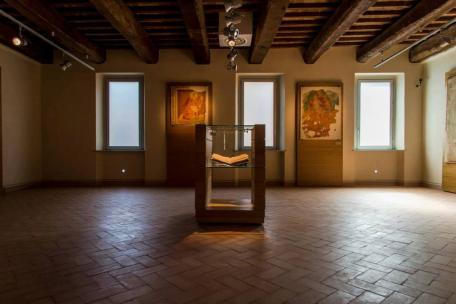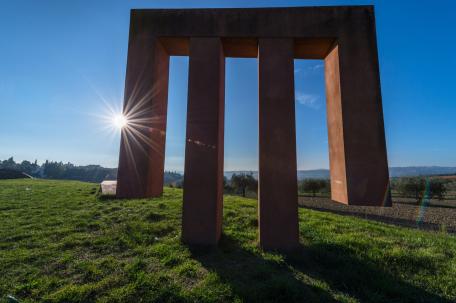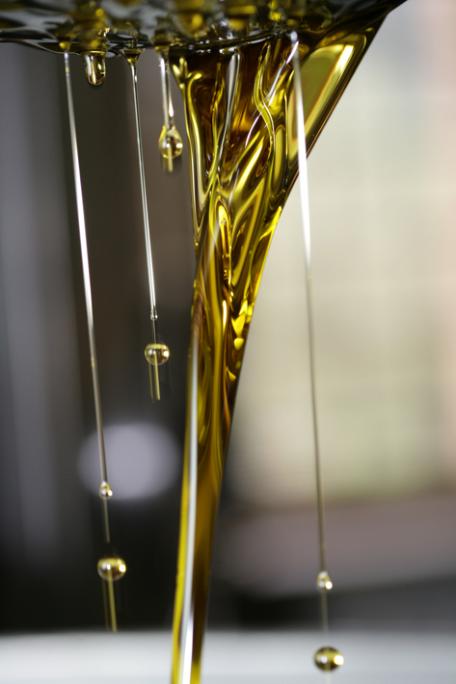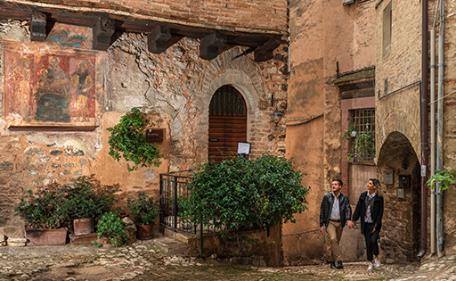| Start | Torgiano |
| Arrive | Torgiano |
| Distance | 8 km by foot - 7.5 km by bicycle |
| Height difference | 60 m |
| Difficulty | easy, mainly flat route |
| Route duration | 2.5 hours (Trekking) - 50min (Bike) |
| recommended bike | city-bike, MTB, gravel |
| Suitability | suitable for everyone, including families with children |
This scenic loop trail is a mostly flat path, departing from the center of Torgiano (PG). It starts at La Torre parking lot (there is an electric car charging point in the car park) near the Baglioni Tower which is the symbol of the medieval village of Torgiano. Up until the mid-fifteenth century, the Baglioni Tower constituted the entrance to a customs area, where goods and products from a vast area of central Italy converged and embarked for Rome via the Tiber river.
Starting from the recently renovated Baglioni Tower, head towards Corso Vittorio Emanuele II, the main street in the historic center of Torgiano. Passing the Palazzo Comunale, (or town hall) on the left, you also goes by the noteworthy Oratory of Sant'Antonio on the right. Built in the 15th century in conjunction with the foundation of the Confraternity of Sant'Antonio, you can admire a 16th century fresco outside the building. Depicting the "Madonna with Child", it is attributed to the school of Domenico Alfani, a well-known Perugian painter of the first half of the sixteenth century, and pupil of Raphael.
The path proceeds to the end of the Corso, where a sharp bend to the left leads to Via Tiradossi. From here it is possible to access, turning right downhill after about 200 meters, the Tiber River Park- an evocative route that winds along the Tiber River to the point of its confluence with the Chiascio river.
This area called, "Parco dei Mulini" or "dei due fiumi"(mill park or park of two rivers) is today a river park, which gets its name from the presence of ancient mills for grinding wheat and olives, that are still clearly visible along the route.
At the end of the descent, the path turns to the right onto an asphalted road which continues for about 500 meters, immersed in a green area leading to the Via Tevere where on the left lies the choice to follow the trekking trail, and on the right follows the bike path. The panorama opens onto scenic countryside, while the route continues, bringing you to an intersection with Provincial Road SP403. Continuing straight onto a dirt road which meanders around a large vineyard, there is a wonderful view of the village of Torgiano from below. Keeping to the right on this path which flanks Via Perugia, the loop around the large vineyard ends back at the crossroads with Provincial Road SP403, where the route doubles back along the same path for about 400 meters. A deviation on the right leads to an increasingly close proximity to the Tiber River, and eventually reaches the area of confluence between both the Tiber and Chiascio rivers.
The dirt road then continues along the course of the Chiascio, skirting the ancient mills of which the territory is renown: The mill known in historical times as Molino della Palazzetta is still active today as Molino Silvestri, which applies the time honored driving force of water combined with actual stone millstones in the production of fine flours, bran, tritello and trivellino. It is a rare find of the oldest historical and cultural tradition of this region: the only fourteenth-century tower in Umbria that stands about three stories tall in the middle of the water.
Upstream from the Rosciano bridge, we find the mill or Molino, now owned by Orcidi, transformed into a private home after the nineteenth-century deviation of the course of the Chiascio river. Downstream from the bridge, with a medieval tower, stood a grain mill. Before arriving near the bridge of Rosciano you can admire the waterfalls of the Chiascio River and a scenic clearing. Further on, turn left onto Via dei Mulini and then go up left onto Via Olivello from where you return to the La Torre parking lot.
In the historic center of Torgiano, near the route, it is possible to visit:
- Muvit - Torgiano wine museum
Torgiano, a medieval castrum based on Roman ruins on the outskirts of Perugia and Assisi, today widely known for its DOC and DOCG wines. The MUVIT Wine Museum was conceived and created by Giorgio and Maria Grazia Lungarotti, it was opened to the public in 1974 and is managed by the Lungarotti Foundation. The museum is located in Torgiano, in the pars agricola of the monumental Graziani-Baglioni palace, a patrician 17th century summer residence. The museum itinerary, developed along twenty rooms with over 3000 works on display, offers a real journey through 5000 years of wine history and culture, analyzing uses and consumption, mythological and legendary aspects and the multiple symbolic meanings connected to the drink that was dear to the gods.
Archaeological finds from the third millennium BC to the Roman age, tools and technical equipment for viticulture and winemaking, ceramic wine containers of the Middle Ages, Renaissance, Baroque ages as well as contemporary, engravings and drawings from the 15th to the 20th century and and other testimonies of decorative arts contribute to document the importance of wine in the collective imagination of the peoples who have lived, over the millennia, around the Mediterranean and in continental Europe. The individual collections on display at the museum are organized into thematic sections according to rigorous scientific criteria and propose the wine and the Dionysian theme as common threads.
- MOO - Olive and oil museum
The hills surrounding Torgiano are rich in olive trees and olive growing has always been one of the main productive activities in the area.For this reason the MOO - olive and oil museum was born, located in a small cluster of medieval houses within the castle walls and is managed by the Lungarotti Onlus Foundation. The museum itinerary develops along eleven rooms and opens with information written by the C.N.R. (National Research Council) on the botanical characteristics of the olive tree, on the most widespread cultivars in Umbria, on the traditional and most innovative techniques of cultivation and oil extraction, together with maps on the historical diffusion of olive growing. The following rooms are set in the premises that were formerly home to an olive press, active until a few decades ago; they host a rich documentation relating to the history and evolution of olive oil machines: from the first stone mortars of the 5th millennium B.C. to the introduction of the trapetum (the tub of Greek origin, used by the Romans, with two hemispherical rotating wheels), up to the reference to the most modern systems and to the invention of the “continuous cycle” system that marked the start for the modern olive oil extraction system.
The path continues on the two upper floors, where the presence of oil and olive trees in daily life, the uses and values attributed to them over time are documented in sections: the mythological origin of the plant, the importance of olive growing, from the Roman economy to the medieval revival up to recent centuries, oil as a source of lighting, in Mediterranean monotheistic religions, in medicine and nutrition, in sports, in cosmetics, as a source of heating and as a significant element of popular lore that attributed, and partially still does, symbolic, propitiatory, apotropaic and curative values to the plant and the product derived from its fruit.
The Museum is directed by the art historian and archivist Maria Grazia Marchetti Lungarotti.
- MACC - Museum of Contemporary Ceramic Art
At Palazzo Malizia, in Piazza della Repubblica in Torgiano, there is the "MACC - Museum of Contemporary Ceramic Art", which includes two permanent collections: Vaselle d'autore per il Vino Novello (Author's Vases for the New Wine): exhibits jugs, called "vaselle" in the Umbrian tradition, made by contemporary artists who, every year, reinterpret the ancient and popular tradition of terracotta by proposing new types of vases to celebrate the new wine. Since 2010, the "Vaselle d'Autore" event has been part of the "Versando Torgiano" event, which has further emphasised the importance of wine as a typical product of these lands.
The exhibition of the sculptor and ceramist Nino Caruso: includes a conspicuous collection of about 60 works created from the 1950s to the present day. The works, which document the sculptor's entire artistic career, are evidence of contemporary ceramic art. Vases, oil lamps and steles evoke archaic forms of ancient civilisations, especially Etruscan, but also African.
Website: www.macctorgiano.it
- The Graziani Baglioni Villa
Located on the corner between the main street of Corso Vittorio Emanuele II and Piazza Baglioni, The Graziani-Baglioni, is a fine example of an agricultural-noble house in this unique area of Umbria.
The sober structure, which dates back to the end of the 17th century and incorporates the remains of older historical buildings, is divided into three floors. At the entrance there is a terracotta plaque engraved with the year 1694, perhaps in memory of the end of the construction work.
The front facade looks out over Corso Vittorio Emanuele II, on which both the main door and the secondary door open. The main door gives access to the staircase through which the residential part of the building is reached, while the latter constitutes the entrance to the agricultural part of the building, with rooms once used for the administration of land property, for the equipment needed in the processing of agricultural commodities and for the storage of products.
Today this entrance leads to the Muvit Wine Museum, a private museum founded in 1974 by the will and commitment of Giorgio and Maria Grazia Lungarotti. The residential part of the building, that until recently was still used as a private residence by the heirs of the Baglioni family, preserves on its main floor a gallery frescoed in the second half of the eighteenth century by Paolo Brizi (1702-1773), with a representation of the four continents. This area of the building also houses a library enriched with literary texts of great theological and cultural interest and numerous rooms embellished with period furniture. In the hall dedicated to large arms, on either side of the imposing fireplace, two cannons known as, “cannoncini di allegrezza” from the end of the 16th century are preserved along with other noteworthy pieces of artillery.
Another side of the building overlooks a beautiful garden, bordered by a seventeenth-century wall and by what were once the stables. Outside, in a niche, you can admire the fresco by Mario Madiai (Siena, 1944): Resurrection of 1998, one of the contemporary signs present in the city.
In front of the main entrance of the building there is another garden, framed by an eighteenth-century elegant architecture in terracotta and closed by means of an iron gate, dominated by the coat of arms of the noble Graziani family.
- Church of San Bartolomeo
The parish church of San Bartolomeo, located in the historic center, was built at the end of the 13th century. In this epoch, the construction of the castle and the incentives promoted by the Municipality of Perugia to favor its rapid population also made it necessary to build a place of worship. However, the current appearance of the church is the result of the demolition of this original structure, which took place at the end of the 18th century. At that time, in accordance with the basilica design planned by the Roman architect, Antonio Stefanucci, a new church was immediately erected and completed in 1805.
It has a facade covered in terracotta. A square bell tower is housed in an ancient castle structure, that once was designated as a city cemetery. In the Middle Ages this constituted the keep of the eastern gate of the castle. At the base of the bell tower is the "Oratorio della Compagnia della Morte, o della Misericordia", built in 1587 and restored, as the inscription under the tympanum recalls, in 1714. It is currently deconsecrated and is used for cultural exhibitions.
Inside, the Church of San Bartolomeo has a single nave with a barrel vault and apse decorated by Ascanio Guglielmo di Panicale and Gaspare and Olimpio Colli di Piegaro in 1937. Above the four side altars, in gilded stucco of eighteenth-century style, some pictorial and sculptural works are placed. These include a Deposition by Felice Pellegrini, an artist of the Barocci school, made in the sixteenth century as narrated in the inscription: "Felix Peregrinus de Perusia inventor pingebat 1588", here probably transferred from the Oratorio della Misericordia; a Marriage of the Virgin dated 1814; a statue of the Immaculate Conception; an Apparition of the Holy Spirit to the Apostles dated from 1590.


















